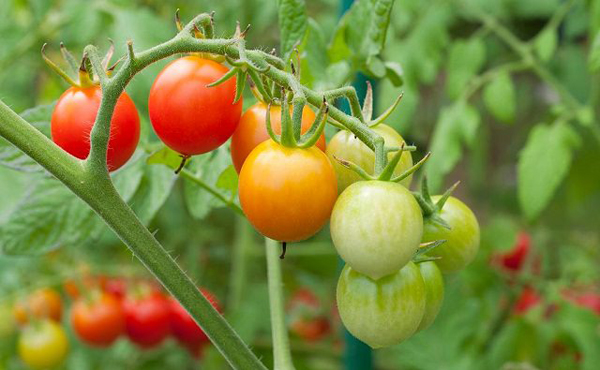
Would anyone argue the deliciousness of a garden fresh tomato? Backyards, farmers’ markets and produce bins showcase the locally grown beauties. Originating in western South America, the Spanish introduced them to Europe. Today, they are the most popular home garden edible.
How are your tomatoes growing? Tomatoes grow best in fertile, organically enriched soil with a pH between 6.0 and 6.5. They need plenty of sun. Tomatoes love warm, not parched, soil. So if you have not yet done so, now is a great time to mulch them.
Of course, mulching conserves water but equally important is its role in preventing the soil and soil-borne diseases from splashing up on the plants. When the plants get to be about three feet tall, remove the lower leaves. They would be the first leaves to develop a fungus problem. You’ve seen it: leaves losing their greenness to a mottled yellow and brown spot, a curling leaf with brown tips. That is a fungal disease that you don’t want to spread.
When you water, focus on watering the roots in the soil, not the plants themselves. Two reasons for this method are minimizing fungus and mold growth plus maximizing the use of your water. They need water regularly. Try to water deeply several times a week rather than a light water every day. A deep watering helps the roots grow down into the soil, extracting nutrients while absorbing water. Irregular watering leads to blossom end rot and cracked tomatoes.
Start watching out for the suckers. These growths are takers and offer no fruit or benefit to the plant. Suckers can be identified as leaf growth that comes out of the joint of two branches. They just take energy away from the plant. The suckers are different than the actual leaf growth.
Don’t be removing too many healthy, green leaves. They are needed for photosynthesis and the production of sugars, making the tomato sweet.
What if your tomatoes don’t flower? Pinching off the stems of the main plant will encourage the plant to flower. Oddly, later in the season, pinching again will encourage the fruits to ripen. Also in the fall, or upon removal of the plant, minimize next year’s blight by removing all of the finished plant and any dropped leaves and branches.
Try to keep the plants off the ground. For me, tomato cages are neither big nor strong enough. If you get a roll of four foot tall fencing and cut it at about three feet, you can make sturdy cages. Roll the fencing and clip it together. They take up a lot of room in the winter but are so useful in supporting the plants. I also use these homemade supports for peas and beans.
If you are container gardening, put in one plant per large pot. Make sure your plants get a minimum of 6–8 hours of sun per day. Do not overwater the container. Keep the plant moist, not damp or soggy.
If you have a few basil plants, go ahead and plant them near the tomatoes. They are companion plants. Many gardeners outline a tomato area with marigolds. The wives’ tale says that they help to keep the bugs away.
Scientifically, the tomato is a fruit, as it develops from the ovary of the flower and contains the seeds of the plant. They are a major dietary source of the antioxidant lycopene with concentrations increasing with the redness of the fruit. They are also a great source of vitamins C and K, potassium and folate, giving a nutritional benefit to every delicious bite.
There are hundreds of tomato varieties in the world. What are the basic differences and uses? From NatureFresh Farms, I got these descriptions:
– Many consider the grape tomato to be the perfect balance between acid and sugar, creating a delicious taste. They are meaty and versatile and can be used in salads, for snacking, in sandwiches, or for grilling and roasting.
– Red Beefsteak tomatoes are considered the King of the Tomatoes. It is the tomato for salsas. They are juicy with a mild flavor and the traditional tomato taste. Best used in sauces, salsas, grilling, dips and burgers.
– Green beefsteaks are tart and crunchy. They can be used in sandwiches, desserts, salsas, sauces, juices, pickling and grilling.
– Cherry tomatoes have a candy-like sweetness. Often used for snacking, also consider use in salads and sauces or for grilling and skewers.
– Cocktail tomatoes have an herbaceous aroma with a sweet, fruity aftertaste. They are soft-walled, meaty with few seeds. Use them in sauces, roasting, stuffing, salads and pasta.
– Roma tomatoes have a full-flavored, tangy, traditional taste. They are meaty, so use in sauces, sandwiches and salads.
– Heirlooms liven up a menu. They vary greatly in color, texture and flavor.
Enjoy!
___
Market Activities for June
The Rutherford County Farmers’ Market is held from 7 a.m. to noon each Tuesday and Friday at the Lane Agri-Park Community Center, 315 John R. Rice Blvd., Murfreesboro. It is a producer-only market.
FREE Classes are held at the Community Center Classroom each day the Farmers’ Market is open. They start at 9 a.m. and last about one hour.
June 4: 4-H STEM – Build a Boat
June 7: Organic Fertilizers for Yardeners
June 11: Freezing Foods
June 14: Butterfly Gardening
June 18: 4H STEAM
June 21: Low-Input Landscapes
June 25: Seasonal Eating
June 28: Dairy Product Fermentation
July 2: Cooking with Kids
July 5: Vermicomposting
Additionally, the Murfreesboro Saturday Market on the Square is held each Saturday through October from 8 a.m. to noon.
And the Smyrna Depot Farmers’ Market opens June 15 and will continue each Saturday from 8 a.m. to noon on Front Street in downtown Smyrna.













